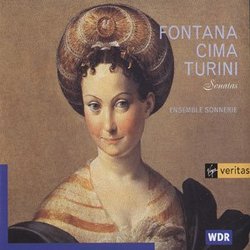| All Artists: Andrea Cima, Giovanni Paolo Cima, Giovanni Battista Fontana, Francesco Turini, Ensemble Sonnerie, Monica Huggett Title: Italian Instrumental Works From the 17th Century Members Wishing: 0 Total Copies: 0 Label: Virgin Records Us Release Date: 10/22/1996 Genres: Special Interest, Classical Styles: Chamber Music, Historical Periods, Baroque (c.1600-1750), Instruments, Brass Number of Discs: 2 SwapaCD Credits: 2 UPC: 724354519925 |
Search - Andrea Cima, Giovanni Paolo Cima, Giovanni Battista Fontana :: Italian Instrumental Works From the 17th Century
 | Andrea Cima, Giovanni Paolo Cima, Giovanni Battista Fontana Italian Instrumental Works From the 17th Century Genres: Special Interest, Classical
|
Larger Image |
CD Details |
CD ReviewsThe sonata perfected scott | Calgary, Canada | 06/03/2008 (5 out of 5 stars) "At the very beginning of the 17th century, the Italians were busy completely reforming music, and ushering in what would come to be called the Baroque. The main development was in vocal music, with a desire to re-create the sounds of the ancients. This gave rise to what we call recitative; a very free way of singing that gives prominence to the text, and tries to emulate natural speech rhythms, all underpinned by the "basso continuo" which harmonically supports the singer.
This same principle was also applied to instrumental music. The Italians took the canzona form (itself a development of the French chanson) and created pieces that depended less on polyphony, and focused more on a melody instrument supported by the basso continuo. Among the most important composers of these sonatas were Castello, Marini, Frescobaldi, Uccellini, and the composers on the present disc; Fontana, Turini and Cima (Andrea and his brother Giovanni Paolo). The Cima brothers wrote some of the earliest published pieces entitled "sonata" and they are worth hearing. There are only six recorded here, each with different scoring. Turini is represented by six sonatas for two violins and continuo. They are early trio sonatas, but are still related to the canzona. The real meat of these discs are the 16 sonatas by Giovanni Battista Fontana published in 1630. For one, two, and three instruments with bass, they are some of the most progressive sonatas to be written to that date. Only Dario Castello was writing anything as exotic and challenging at the time, and like Castello, we know almost nothing about Fontana. These 16 pieces comprise his complete surviving output, but they are fantastic and ensure him a place in music history. The performance by Ensemble Sonnerie is about perfect. The main players are Monica Huggett and Pavlo Besnosiuk (violin), Bruce Dickey and Doron Sherwin (cornetto), Stephen Saunders (sackbut), and Francis Eustace (dulcian) with a large and varied continuo team. All very good early music specialists, and they tackle this difficult repertoire superbly. The endless invention of the music, coupled with the varied instrumentation means there is never a dull moment over almost two and a half hours of listening. This is a an important recording of significant works, and should be in the collection of any serious early music fan." |

 Track Listings (13) - Disc #1
Track Listings (13) - Disc #1